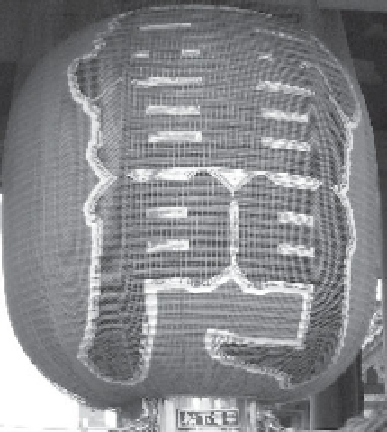Graphics Reference
In-Depth Information
Figure 4.18.
Correspondences obtained using the nearest neighbor distance ratio to match SIFT
descriptors computed for images taken of the same scene under different imaging conditions.
Most of the matches are correct.
length. The overall normalization makes the descriptor invariant to affine illumi-
nation changes, and the zeroing-out step prevents large gradients (which may be
erroneous or viewpoint dependent) from dominating the descriptor.
Figure
4.18
illustrates the result of using the nearest neighbor distance ratio to
match the SIFT descriptors between two images taken from different perspectives
with different resolutions and illumination conditions. We can see that many of the
correspondences are correct in terms of thematches' location, scale, and orientation;
the incorrect correspondences can be removed with an outlier rejection rule based
on the images' epipolar geometry, as discussed in Section
5.4
.
4.2.3.1 GLOH
Mikolajczyk and Schmid [
328
] proposed a SIFT variant called
GLOH
(for Gradient
LocationandOrientationHistogram) that they claimedoutperformedLowe's original
formulation. Instead of using a square grid as the domain for orientation histograms,
a log-polar grid is created, as illustrated inFigure
4.19
. The center region (of radius 6) is
undivided, while the two outer rings (of radii 11 and 15) are divided into eight regions.
The gradients in each grid region are quantized into sixteen angles (as opposed to
eight for SIFT). Thus, the raw descriptor is 17
272-dimensional. Based on a
training set of imagepatches, principal component analysis (PCA) is applied to reduce
the dimensionality of the descriptor to 128.
×
16
=
4.2.3.2 DAISY
Winder andBrown [
548
] andTola et al. [
490
] suggesteda generalizedhistogram-based
compute histograms, we specify the centers of “soft” support regions and a Gaussian
11
The name DAISY comes from the petal-like appearance of the descriptor support regions.



